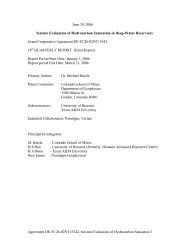Upgrading of Low-Rank Coals - National Energy Technology ...
Upgrading of Low-Rank Coals - National Energy Technology ...
Upgrading of Low-Rank Coals - National Energy Technology ...
You also want an ePaper? Increase the reach of your titles
YUMPU automatically turns print PDFs into web optimized ePapers that Google loves.
14<br />
ACCP Process Description<br />
The SynCoal ACCP enhances lowrank<br />
subbituminous and lignite coals by<br />
a combination <strong>of</strong> thermal processing and<br />
cleaning. The results are a reduction in<br />
moisture content from 25–40% in the<br />
feed to as low as 1% in the product,<br />
concurrently increasing heating value<br />
from 5,500–9,000 Btu/lb to as high as<br />
12,000 Btu/lb, and reducing sulfur content<br />
from a range <strong>of</strong> 0.5–1.5% to as low<br />
as 0.3%. The process consists <strong>of</strong> three<br />
major steps: thermal treatment in an<br />
inert atmosphere, inert gas cooling <strong>of</strong><br />
the hot coal, and cleaning. The thermal<br />
upgrading removes chemically bound<br />
water, carboxyl groups, and volatile<br />
sulfur compounds. The cleaning step<br />
separates the pyrite-rich ash, thereby<br />
reducing the sulfur content <strong>of</strong> the product.<br />
Each ton <strong>of</strong> raw Rosebud subbituminous<br />
coal produces about 2 / 3 ton <strong>of</strong><br />
SynCoal.<br />
Raw coal from the Rosebud mine<br />
unit train stockpile is screened and fed<br />
to a vibrating fluidized-bed reactor,<br />
where surface water is removed by<br />
heating with hot combustion gas. Coal<br />
exits this reactor at a temperature<br />
slightly higher than that required to<br />
evaporate water and is further heated<br />
to nearly 600°F in a second vibrating<br />
reactor. This temperature is sufficient<br />
to remove pore water and cause decarboxylation.<br />
In addition, a small<br />
amount <strong>of</strong> tar is released, sealing the<br />
dried product from reaction with oxygen.<br />
Particle shrinkage causes fracturing,<br />
destroys moisture reaction<br />
sites, and liberates the ash-creating<br />
mineral matter.<br />
The coal then is cooled to less than<br />
150°F by contact with an inert gas<br />
(carbon dioxide and nitrogen at less<br />
than 100°F) in a vibrating fluidized-bed<br />
cooler. Finally, the cooled coal is fed to<br />
deep bed stratifiers where flowing air<br />
and vibration separate mineral matter<br />
from the coal by rough density-based<br />
separation. The low-specific-gravity<br />
fractions are sent to a product conveyor<br />
while heavier fractions go to<br />
fluidized-bed separators for additional<br />
Location<br />
The demonstration plant is located<br />
adjacent to the unit train loadout facility<br />
within Western <strong>Energy</strong>’s Rosebud mine<br />
boundary near Colstrip, Montana. The<br />
production unit, having a capacity <strong>of</strong><br />
1,000 tons/day <strong>of</strong> upgraded coal, is onetenth<br />
the size <strong>of</strong> a commercial facility<br />
and benefits from the existing mine and<br />
community infrastructure.<br />
Product Characteristics<br />
SynCoal is a high quality product with<br />
less than 5% moisture, sulfur content <strong>of</strong><br />
about 0.6%, ash content <strong>of</strong> about 9%, and a<br />
heating value <strong>of</strong> about 11,800 Btu/lb. The<br />
enhanced properties <strong>of</strong> the product provide<br />
evidence that the molecular structure <strong>of</strong><br />
ash removal. Different procedures for<br />
product stabilization are used, depending<br />
on feed coal and market application.<br />
Fines from various parts <strong>of</strong> the cleaning<br />
process are collected in baghouses and<br />
cyclones, cooled, and made available<br />
as an additional product line.<br />
Most <strong>of</strong> the heat rejection from the<br />
ACCP is accomplished by discharging<br />
water and flue gas to the atmosphere<br />
through an exhaust stack. The stack<br />
design allows for vapor release at an<br />
elevation great enough that, when<br />
coupled with the vertical velocity<br />
resulting from a forced draft fan, dissipation<br />
<strong>of</strong> the gases is maximized.<br />
Heat removed from the coal in the<br />
coolers is rejected using an atmospheric<br />
induced draft cooling tower.<br />
The fines handling system consolidates<br />
the coal fines that are produced<br />
in the conversion, cleaning, and material<br />
handling systems. The fines are<br />
gathered by screw conveyors and<br />
transported by drag conveyors to<br />
a bulk cooling system.<br />
low-rank coals can be altered successfully<br />
to produce a unique fuel for a variety <strong>of</strong><br />
utility and industrial applications.<br />
Operating History<br />
Design and Initial Operation<br />
The Cooperative Agreement with DOE<br />
for the ACCP demonstration facility was<br />
signed in September 1990. Initial operations<br />
began in April 1992, with the first 24-hour<br />
run occurring in May 1992 and the first significant<br />
shipments in June. Several material<br />
handling problems were encountered during

















